AIS SART plotting, & NMEA 2000 AIS problems
A gold star to Raymarine for the E140W’s response to an AIS SART test! This seems like exactly the proper plotting behavior described by the USCG AIS expert Jorge Arroyo in a comment to the entry about the easyRescue SART tested. Not only did the E Wide put up an alarm noting the SART TEST message but it also plotted the SART’s location with the correct distinctive icon (see inset above). And, as a bonus, it’s giving the operator quick soft key or touch shortcuts to setting up a go-to-SART route or dismiss the alarm. But so far the E140W is the only MFD that’s so SART friendly and it wasn’t until I updated its software this weekend…
In fact, until software release v2.49, the E140W wasn’t doing AIS well at all, at least via NMEA 2000. I have it on a backbone with a Garmin AIS 600, and while it would see AIS targets, they used to disappear intermittently but regularly. Mind you that both the E140W and AIS 600 are NMEA 2000 certified products, and guess what? Even after the software upgrade, the E140W is still not seeing Class B static data (vessel name, dimensions, type, etc.) being sent by the AIS 600. That regular AIS icon on the inset above is the lab’s Class B transponder and that’s also a Class B on the mighty Fife ketch Sumurun (which is prepping for the NYYC’s Transatlantic Race at Wayfarer Marine). The Class B targets plot fine, but no matter how long I leave the system on the vessel names never show up.
And the plot thickens. The Garmin 7212 and 740 displays in the lab show all the standard Class B (and A) data fine, but they only show AIS SARTs as a regular target and don’t seem to show any AIS messages, despite the fact that they too were updated in the last few days (tis the season). While the Lowrance HDS and Simrad NSE do show the SART ACTIVE and SART TEST messages, as illustrated the other day, they too seem unable to decipher the Class B static data PGN coming from the AIS 600. Damn it! I understand that it will take a while for the coders to catch up with the new SART messages, and I understood how early NMEA 2000 AIS got a little screwed up because NMEA was slow to write a standard PGN for Class B Static Data. But we were talking about that almost two years ago!
Frankly, I’m not sure that either the Simrad AI-50 or the Raymarine AIS 300 have yet been updated to output those standard Static Data PGNs — there are actually 2 Class B Static Data messages, A and B — and it seems like their makers’ MFDs can’t read them yet anyway. (But remember that both early N2K transponders included proprietary ways to pass static data to their own plotters, because the standard PGN wasn’t available). Or could it be that the AIS 600 is sending improper Class B Static Data PGNs? Well, here’s some evidence that they’re fine, and also that one of my favorite tools may be a little flawed in this regard…
Above is an Actisense NMEAReader screen showing details of four different AIS PGNs coming from the Garmin AIS 600. On the left are the two Sumurun Static Data messages that the E140W, NSE12, and HDS10 all fail to read, and on the right are the easyRescue’s Class A Position Report, at least plotted by all, and its AIS Safety Related Broadcast Message, displayed by some. I know I’ve gotten way geeky here, but this is a terrific tool for trouble shooting N2K (and 0183) issues like I’m discussing. However, we must realize that those PGN translations are written in by the software developer and are also subject to “issues.”
For instance, check out what the wonderful Maretron N2KAnalyzer has to say about the same data. It translations the SART PGNs very similarly, but note how the two Class B Static Data PGNS — 129809 and 129810 — are simply marked “Unknown.” Doh! I think this is just an omission on Maretron’s part, as those numbers check out in NMEA’s PGN database, but I’m not sure of anything anymore. I really like both NMEA 2000 and AIS, and they should work beautifully together…but so far the relationship is messy.


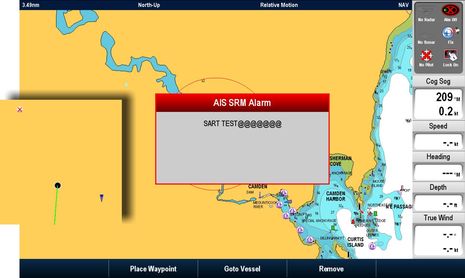
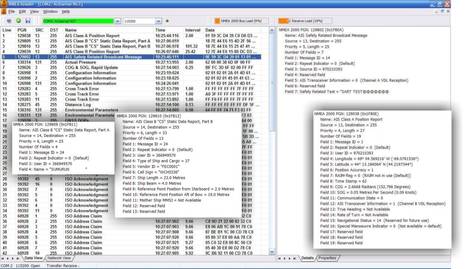
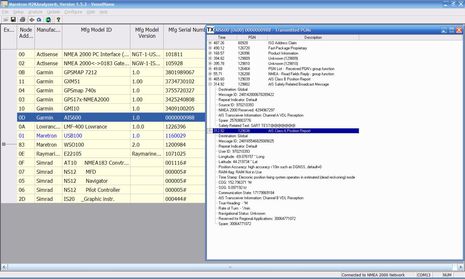
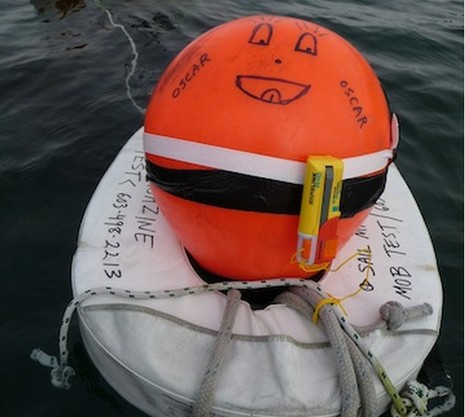
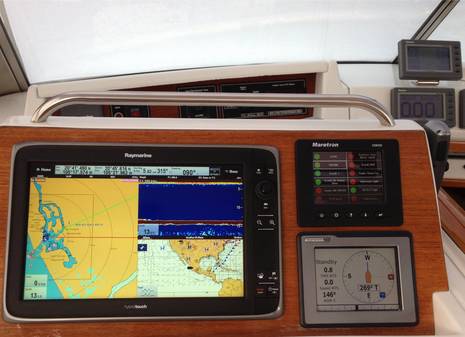

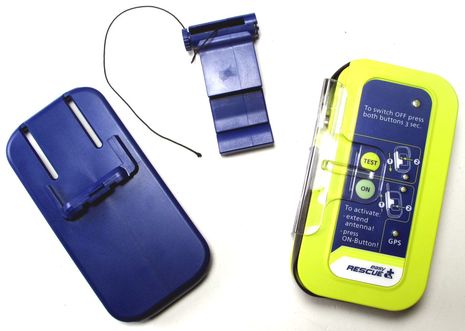







A thought. Perhaps future MFD’s or VHF radios will allow you to create a list of MMSI numbers for all your AIS SARTS, and should one of them become active:
– command your VHF radio to activate DSC alert
– command the autopilot NOT to run you over but stay close using the continuous asnd accurate lat & long from the SART. A boat going in a circle is sure to attract attention of someone sleeping inside the cabin and/or nearby boaters without AIS or current AIS software.
Really interesting to see the MFD / AIS NMEA 2000 interop issues. You have the PC connected any plans to compare the PC Software as well?
Thanks,
-p
Yes Ben, please test on some PC programs. I love the idea of the AIS SART but wonder if it needs to be combined with some other alarming system to really operate as a MOB device. Curious how something like the Vesper AIS WatchMate responds as it has loud alarms. If it set off an alarm when it got an AIS SART message, it would be a worthwhile addition to create a VERY capable MOB alarm and recovery system.
Thanks for mentioning Vesper Marine, Gram. Their AIS plotters definitely understand AIS SARTs — which I’ve seen myself, http://goo.gl/DplN7 — and they have audio alarms plus relays for bigger alarms. So I think your concept is quite doable.
And, yes, I will test the AIS SART with PC charting programs, but in most cases it will take a NMEA 0183 connection. Even some of the programs that do support NMEA 2000 — like Nobeltec 11 and MaxSea TZ — don’t yet support AIS over N2K, I’m pretty sure.
The best combination for MoB is DSC and AIS:
DSC will alarm, and AIS will plot.
Also, using both technologies maximises the potential SAR response, as not all small boats have AIS, but many have DSC.
Rgds
Glenn
Hey Ben, I hear your frustrations about lack of N2K support for AIS – it seems NMEA catches flak for not moving quickly enough, but as you point out, it’s not the association dragging its feet here, it’s the manufacturer’s. At least Garmin, Raymarine, and Simrad are trying to get it right – Furuno still refuses to output their AIS data on to the N2K port, forcing users to create additional connections and complexity in order to use PC charting configurations…
Glenn, I agree that there may be a place for some combination of AIS SART and DSC for crew overboard protection, but I think a lot of boats are most concerned about self rescue, and it seems like that can be done pretty well using either technology. It also seems like there will be even more MoB device choices in the future than there are now.
Grant, I think the N2K AIS problems began because the NMEA that was quite slow to publish a Class B Static Data PGN and so Navico and Raymarine had to use proprietary PGNs to make their N2K transponders work right. But now those manufacturers are being slow to update their transponders and MFDs for the standard PGN. There’s a ripple effect that’s pretty annoying if you’re trying to mix different brands of transponders or receivers and plotting devices. And apparently NMEA 2000 certification doesn’t apply!
At any rate, it’s interesting that the new AIS SARTs can work fine over N2K because there was no real change to the existing AIS messages and their N2K translations. The folks coding plotting applications just have to start displaying SRM messages, if they weren’t already, and activate the SART icon when the Navigation Status in the Class A Position Message = 14 (which used to be “reserved for future use” but is now designated “SART”).
PS: Last night I updated the Lowrance HDS with new 4.0 software and while it has some great new features, it still does not seem able to decipher the Class B Static Data PGNs discussed above.
PPS: That link under Glenn’s comment above leads to a great explanation of GMDSS, problems included:
http://www.gmdss.info
Ben,
As of two weeks ago there was no software update for the Navico AIS-300 either, so it doesn’t send anything but the Simrad-specific Class B PGNs out over NMEA 2000. There is a small bug in that in that the HDS thinks that all Class B ships heading is 188 degrees true. The HDS does show all other Class B data correctly as long as it comes from the Navico AIS transceiver.
Frustrating indeed.
I am reminded of this recent Panbo entry https://panbo.com/archives/2010/03/navicom_rt-650_mob_doing_it_all_somewhere_else.html
It even controls the autopilot.
An idea that is thinking way ahead (past the standardization / software release issues) would be a combination product of a MOB base station capable of sending out a DSC alert supported all three of (i) a small simple MOB sensor (like an RFID chip, the absense of which sets an alarm), an enhanced MOB with a combination RFID and AIS SART capability, and a throwable AIS SART on a float with a flashing light on top that is mounted in the cockpit and activate on contact with the water (to throw into the water after someone without the SART version of the product is MOB)
Then a boat equipped with the combination of the three is covered in many crewing situations from single handed operation on up.
Ben,
Any word if Raymarine is going to do us E-Series Classic owners right and enable NMEA2k support of AIS in the next (and final!?) firmware release? I talked to them in February, and was told there was supposed to be one more firmware release, and that AIS over 2K is not on the feature list…
Navico still(!) does not support the AIS Class B Static Data PGNs 129809 and 129810.
Here’s a radical thought: if a product is not compatible with the standard PGNs for the features it uses, then it is not NMEA 2000 compatible and NMEA should revoke its approval (after a grace period).
It’s frustrating that some NMEA matters move at glacial speeds.
Even NMEA 0183 AIS integration is sketchy. I have NMEA 0183 data available from my VHF radio, which I can send wirelessly to my iPad or Mac. In the cockpit, however, I cannot display this AIS data on my nice new Raymarine i70s with their dedicated AIS page. I just spoke with a Raymarine tech who confirmed that neither their AutoPilot NMEA IN, PC/Seatalk Interface, nor their new SeaTalk to SeaTalkng converter can convert NMEA 0183 AIS data. He was certain that one of their MFDs would solve this issue, though.
Does anyone have another idea about how to do this? Like, perhaps, the Actisense NGW-1 AIS? Newest firmware indicates it can convert VDM and VDO to NMEA 2000 PGNs. Can these be dropped onto a SeaTalkng backbone for display on the i70s?
Cheers,
Doug
Norse, I used to think that your “radical thought” made tons of sense, but not anymore. As I understand it, NMEA does not regulate or test what data messages (PGNs) a particular device sends or displays. The focus of NMEA is network behavior, not content. They’re concerned that PGNs get where they’re suppossed to go, not what they say. That’s critically important, but it also means that a consumer can buy a certified N2K AIS receiver or transponder that does not output standard AIS PGNs!
As “obviously” crazy as that sounds, consider what NMEA would have to do to fix it. Committees would have to be formed to determine exactly which PGNs each particular type of sensor or device would be required to output. Heck, there would probably have to be a committee to define what each type of sensor or device was! Then the N2K software test tool would have to be modified to somehow check that every type XXX device output every YYY message, and that might be expensive.
Do you really want to go there? Me neither!
The situation with the Navico AIS transponders happened because they developed their products before NMEA got around to writing the standard Class B PGNs (and note that Navico MFDs understand the proprietary Class B PGNs that Navico wrote). I castigated NMEA about this at the time, but let’s not slow them down any further now. The only solution to this sort of problem that I see is putting the heat on manufacturer who doesn’t update their products when standard NMEA PGNs become available. Feel any warmer, Navico?
You’re right, I would rather Navico fixed it than create more bureaucracy. It’s not quite that hard though if the check is limited to the proprietary PGNs and seeing if there is a standard one which could be used instead. As far as I know there is only one such problem case right now. Do companies have to get some clearance from NMEA before creating proprietary ones?
Interesting discovery: The latest Simrad AI50 manual (2011) shows that it does support PGN 129040, which is called an Extended Position Report but seems to contain all the Class B Static data too. Is anyone using a newer AI50 with N2K output to a non Navico AIS plotter, and, if so, are you seeing Class B static data like boat name, type, and size?
N2K and AIS = no good
Nah! AIS over NMEA 2000 definitely suffered some glitches but they are almost all solved. See this entry and its comments:
https://panbo.com/archives/2012/06/ais_over_nmea_2000_the_shame_sheet.html
Every day this month I’ve been using a Raymarine AIS 650 on Gizmo’s N2K backbone. The ONLY problem I’ve seen is that one of three Raymarine displays (the e127) sometimes doesn’t get the target info. That’s a mystery, but the Ray a-65 and e-7 displays plus a Garmin 7212 and a Furuno TZT14 are seeing all the AIS target info, including the Class B static data which was a problem.
AIS PRO didn’t tell us why he thinks that, but I disagree. I do complain about problems with certain implementations, but they are few and getting fewer. Anybody buying new equipment now can easily get a system that works very well. After having used N2K, who would want to go back to NMEA 0183?
I agree with norse. I have a (simple) N2K backbone on my boat, and some old NMEA183 gear as well.. I definitely prefer the plug and play functionality of the N2K. All my electronics will be N2K.. It’s easy, reliable, works well, and makes data sharing easy.